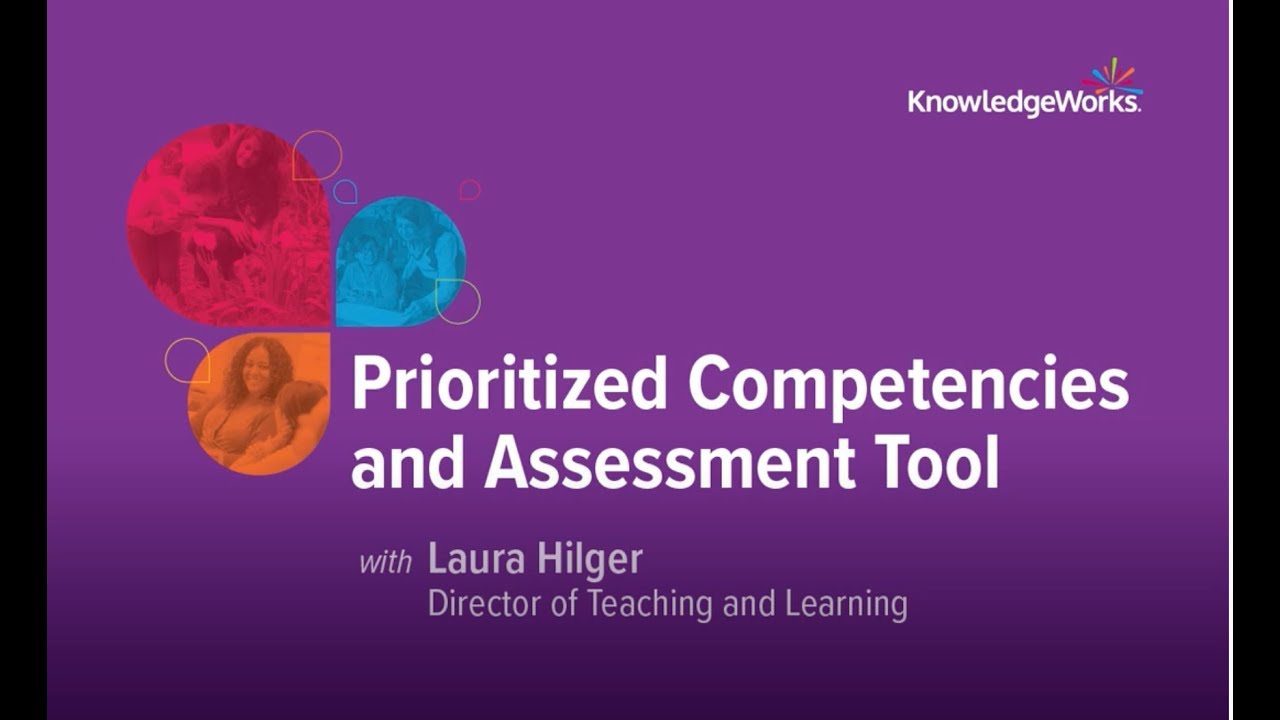When we were creating tools to support the use of the revised edition of the Educator Competencies for Personalized, Learner-Centered Environments, we knew we needed to prioritize competencies that focused on the implementation of personalized, learner-centered environments and the professional development of practices that nourish them.
The video below offers a walkthrough of the prioritized competencies, as well as a guide for how to use The Assessment Tool for Prioritized Competencies, which can be used either in self-assessment or as a walkthrough for your learning community or in classrooms to help you figure out where you are in your learning journey.
- Download The Reflection Tool for Prioritized Competencies
- Download the Prioritized Competencies

Laura Hilger: Hi everyone. My name is Laura Hilger and I am a director of teaching and learning for KnowledgeWorks. Today, I’d like to talk to you about the toolkit that we created to accompany the Educator Competencies for Personalized, Learner-Centered Environments. We’re going to go over what the prioritized competencies are as well as the assessment tool that we designed to go with those competencies. These tools are for educators and were written with educators in mind so that you can determine your professional learning needs in relation to the educator competencies. It is our hope that this video will help you understand a bit more about how to use the tool as well as the features that accompany it. So with that, you’ll notice that we are looking at the opening page for the prioritized competencies.
You will see that there are six competencies, and these competencies are organized into domains. We have four domains. The first domain is interpersonal, and those competencies deal with things that we believe educators need to reflect on. The interpersonal domain is about competencies that are about relating with one another. And with learners, the cognitive domain is all about what you need to know while the instructional domain handles competencies that you need to do. Now, you might be wondering, how did we determine that these six competencies are the priority? Well, back in the early 2000s, Larry Ainsworth created criteria and organized it into what he called the Objective Selection Criteria. He came up with four categories for us to check, to see if something should be prioritized or essential. Now back then, this was used to create lists around power standards. And of course, since then it has been upgraded. And learning communities can use the Objective Selection Criteria to centralize all kinds of curriculum including competencies.
We at KnowledgeWorks, looked at these four categories and used three of them to help us narrow down to these six. The first category is endurance. To what degree does this competency go beyond a single moment or single scenario? Readiness has to do with, to what degree the competency is required for the next level of implementation. Leverage is to what degree the competency addresses multiple disciplines or contexts. The last category has to do with state tests. And because educators do not go through state tests in the same way that learners do, we did not use that category to help us prioritize. Having said that, learning communities could choose to use their current educator evaluation tools in order to help them come up with alternate prioritized standards. Considering your local contexts, we invite you to dig deeper into the full set of educator competencies. As you might have other competencies that you would prioritize due to your context, identities, implementation, strategic plan, et cetera. For more on prioritizing your competencies or the process of the Objective Selection Criteria, you can check out these additional resources listed on the first page of this tool.
Now that I’ve talked to you about the prioritized competencies, I want to talk a little bit about the assessment tool that we designed that is aligned to those competencies. I’m going to go ahead and page down to the second page of this tool. And once again, this is in the tool kit for the Educator Competencies for Personalized Learner-Centered environments.
The purpose of this assessment tool is to give you indicators so that you can determine where you are in your implementation journey for these competencies. We’ve given you two possible uses for this tool. And I want to briefly talk about those before jumping into the tool itself. The first that we have suggested is that it is a self-assessment tool. And by that, I mean that you can use the tool to determine where you are as a professional in each of the competencies and then narrow down and determine next steps. The other possible use is that you can use it as a walkthrough tool to go through your learning community as a PLC or an instructional rounds team to determine trends, bright spots and or next steps for the teams as a whole.
Regardless of how you use the tool, it does remain the same. And so it’s important that you become familiar with it on your own and in your own way before working with it at a team level. So what I’m going to do before I dive in, is I want to show you one example and we’ll just pick number two here out of the intra-personal domain. And I’m going to break up this tool for you. Each competency has an implementation rubric, and you will see that it is broken into four columns, not unusual for a rubric, but because this is an implementation rubric, I want to go over what those headers mean. So I’m going to the introductory area and you will see that we have unpacked those headers for you. Establishing means that you are beginning the learning for that competency. You have some evidence that shows you’ve started, developing means that you are working towards mastery and your evidence shows that you have been practicing all of the elements of the competency. That’s true.
Operationalizing means that you have mastered the competency, that your evidence shows, that you can demonstrate mastery of each indicator and when applicable, you also have evidence of collaborative learning approaches with your colleagues. In essence, when you are at the operationalizing level, you should have evidence that demonstrates community mastery. Lastly, we have refining, and that means that you have mastered the competency and that you are able to show continuous improvement cycles. And again, those should be collaborative. We’ve also given you some things to consider when it comes to those continuous improvement cycles. With that, I’m going to go back down to our number two, that we’re going to dig into a little bit.
And number two, again, is maintain an orientation toward and commitment to a personalized learner centered vision for teaching and learning. You will see the four columns that I just described and inside the four columns are the indicators for each of those columns.
Now, in order to say that you are developing, that means that you would be able to provide evidence of all three of those indicators in the developing column. Once you can demonstrate that evidence, you are ready to move on to operationalizing and so forth.
What I appreciate about implementation rubrics and rubrics in general, is that they provide clarity on what you need to know and be able to do in order to demonstrate mastery. Rubrics are a game changer when it comes to learning and showing your progress on your learning. And that is true for all different kinds of learners. The more that we can clearly show what the indicators are for the required learning, the more learners are going to be able to own their own learning. And so I really encourage you to dive deep into the columns and unpack them for yourself before you try to figure out where you are. And by that, I mean read all of the indicators. And if you don’t understand a word, I’m going to coach you to go check out our glossary. Once you feel like you understand the indicators, then you might start thinking about where you are and you will notice that the indicator progresses across the rubric. So it is horizontally aligned if you will.
So for example, if you wanted to use this tool to self assess, you might determine that you have evidence that shows you have this establishing indicator and you are ready to go to developing. When you get to developing, investigate personalized learner-centered education and research on its effectiveness for student groups that have been historically marginalized and or least served by public higher education. And you think to yourself, I don’t know if I have evidence for that yet. Then that’s going to tell you that you would want to say that you are working on this indicator and you might think to yourself, what is some professional learning that my district is going to provide, or that I can provide myself in order to make progress on that indicator? You would repeat that process for each of the indicators to determine your overall working level.
It’s important to know that where you have mastered versus where you are working are different. And we’ve explained that up at the intro as well. But briefly, it is highly likely that you could say you are not establishing, that you’ve mastered the establishing column and you’re ready to move on to developing, which means developing is your working level and that you’ve mastered the establishing level. And in order to show that you’ve mastered it, you would have to have evidence for all three indicators.
Now, if your learning community, or your school, or your district wants to use this tool as a walkthrough tool, the same would apply. The only difference is that the teams would be taking the same implementation rubric around and looking at the classroom level, looking for evidence and then you would calibrate and compare notes to determine trends, bright spots and possible next steps. With that, I hope that this has helped you think about how you might use the assessment tool and, or built your understanding for its purpose.
Explore the toolkit and many resources related to the Educator Competencies for Personalized, Learner-Centered Environments.


